Misusing travel adapters can transform a simple plug into a serious fire hazard—tourists have ignited house fires by overloading uncertified or damaged adapters not designed for continuous use.
To stay safe on the road, travelers must master essential practices—from choosing surge-protected, UL- or CE-certified adapters and verifying that their devices support the local voltage to avoiding dangerous daisy-chaining setups—that will prevent electrical damage and fires wherever they roam.
What You Need Before You Start
The Truth About Travel Adapters: Are They Really Safe?
Understanding Travel Adapters and Voltage
Travel adapters come in two main forms—universal and region-specific—each balancing compatibility against size and convenience. Universal adapters are designed to work across multiple plug types worldwide but tend to be bulkier and heavier, making them ideal for multi-destination travelers.
In contrast, region-specific adapters fit a single plug standard (e.g., Type C in Europe or Type G in the UK), offering a compact, lightweight solution when visiting just one area. It’s crucial to distinguish adapters—which only change plug shape—from voltage converters, which actually modify the electrical current between 110 V and 240 V.
You generally need only an adapter for dual-voltage devices (100–240 V), whereas single-voltage gadgets (e.g., hair dryers or curling irons) require a converter to match the local supply voltage.
Types of Travel Adapters
Universal vs. Region-Specific Plugs
Universal adapters support multiple plug types (A, B, C, D, G, I, etc.), making them versatile for globetrotters but adding bulk to your luggage. Region-specific adapters are slim and light—perfect for single-destination trips—but won’t work elsewhere without swapping to a different adapter.
| Adapter Type | Compatibility | Size & Weight | Pros | Cons |
|---|---|---|---|---|
| Universal Adapter | Works in multiple regions (12+ plug styles) | Bulkier, heavier | Covers all major plug types in one device | Heavier, more complex mechanism |
| Region-Specific Adapter | Single region (e.g., Type C, Type G) | Compact, lightweight | Small footprint, reliable connection | Limited to one plug standard |
Adapter vs. Voltage Converter
An adapter simply reshapes your device’s plug to fit foreign outlets without altering the voltage, so it’s safe only if your device supports the local voltage range. A converter (or transformer) actively changes the incoming voltage—stepping it up or down between 110 V and 240 V—to match devices that aren’t dual-voltage.
| Function | Adapter | Converter |
|---|---|---|
| Definition | Changes plug shape only (no voltage change) | Modifies voltage level (step-up or step-down) |
| Use Case | Dual-voltage electronics (100–240 V) | Single-voltage appliances (e.g., 120 V hair dryer) |
| Limitations | Cannot prevent device damage from voltage mismatch | Bulkier, not practical for multiple regions |
Selecting a Safe Travel Adapter
Selecting a safe travel adapter is essential for avoiding electrical mishaps abroad. Always choose adapters bearing UL (Underwriters Laboratories) or CE (Conformité Européenne) marks, as they ensure rigorous testing of insulation, temperature control, and circuit protection.
In markets like Singapore, look for the national SAFETY Mark for additional assurance. Prioritize models with built-in surge protection—such as the Conair Travel Smart Adapter or Ceptics World-Way Kit—to shield devices from voltage spikes, and verify they include overload protection via fuses or thermistors to automatically cut power when currents exceed safe levels.
Brands like Ceptics, Tessan, and Epicka strike an excellent balance of safety features, global compatibility, and compact design, making them top recommendations for worry-free international travel (Amazon).
Safety Certifications and Standards
UL, CE, and Other International Marks
- UL Certification (US): Indicates adapters have passed stringent safety tests—including insulation integrity and flammability resistance—reducing fire risks.
- CE Mark (EU): Verifies compliance with European safety, health, and environmental requirements, ensuring circuit protection and temperature control.
- SAFETY Mark (SG): Singapore’s national mark, confirming products meet local fire-safety and electrical standards, with unique certification numbers traceable to the supplier.
Key Safety Features
Built-In Surge Protection
Travel adapters with surge protection incorporate EMI/RFI filters and surge-absorbing components to guard electronics against sudden voltage spikes. For example, the Conair Travel Smart Adapter features an integrated surge protector and power-on indicator, while the Ceptics World-Way Kit includes built-in surge suppression to protect high-end devices.
Overload Protection Mechanisms
Most high-quality adapters use internal fuses or thermistors that disconnect power when current exceeds safety thresholds. This prevents overheating and potential fires.
Detailed circuit protection often lives on the adapter’s PCB, automatically shutting down under overcurrent conditions, and models like the Fosmon EU-US adapter safeguard against overcurrent and overcharging with advanced internal protections.
Reputable Brands and Models
Recommendations and Quick Comparison
| Brand & Model | Price | Ports (AC / USB) | Key Safety Features | Certification |
|---|---|---|---|---|
| Ceptics GaN 70W Universal | $45 | 1 AC + USB-C + USB-A | GaN tech, surge protection | UL, CE |
| Tessan GaN Universal | $38 | 1 AC + USB-C + USB-A | Surge protection, Power Delivery | UL, CE |
| Epicka Universal Adapter | $25 | 4 AC (Type A/C/G/I) + 4 USB-A + 1 USB-C | Surge protection, fuse safeguard | UL, CE, FCC |
| Ceptics World Travel Adapter Kit | $28 | 2 US outlets + 2 USB | Built-in surge protection, voltage indicator | UL, CE |
These adapters represent top choices for their consistent safety performance, compact design, and global compatibility, ensuring smooth, worry-free charging on any trip.
Pre-Use Checks and Maintenance
Before you plug in, perform three critical pre-use checks—physical inspection, electrical compatibility, and moisture control—to safeguard against arcing, short circuits, and potential fires. Thoroughly examine your adapter for loose prongs, cracked casing, or frayed cables, since damaged conductors are a leading ignition source in electrical fires.
Always verify that both your device and adapter ratings match—look for labels like “Input: 100–240 V” on dual-voltage gadgets or calculate watts (W = V × A) for high-power appliances—to know whether you need only an adapter or a full converter.
Keep adapters dry and clean, because moisture intrusion is a common failure mode that compromises insulation, leading to internal shorts and thousands of home fires each year.
Finally, inspect labels for counterfeit signs—missing UL marks or typos often indicate substandard internal insulation and higher risk of premature failure. Routine checks and environmental vigilance are your best defense against travel-related electrical hazards.
Physical Inspection
Checking for loose prongs, cracked casing, frayed cables
- Inspect contact integrity: Before each use, look for loose or bent prongs and ensure they lock firmly in and out of sockets.
- Check casing condition: Crack-free, intact housing prevents exposure of live components; discard adapters with any visible fractures.
- Examine cable sheathing: Frayed or bare wires dramatically increase fire risk—replace any adapter showing insulation damage.
Electrical Compatibility
Verifying voltage/wattage ratings on devices and adapters
| Device Type | Voltage Label | Converter Needed? |
|---|---|---|
| Dual-voltage electronics (e.g., phone chargers) | 100–240 V | No – adapter only |
| Single-voltage appliances (e.g., hair dryer) | 110 V or 220 V | Yes – use appropriate converter |
- Read the fine print: Examine plugs or user manuals for “Input: 100–240 V” to confirm dual-voltage compatibility and avoid unnecessary converters.
- Calculate wattage for high-power devices: If no wattage label is present, compute W = V × A to choose a converter rated above your appliance’s draw.
- Match polarity and frequency: For DC devices, ensure the adapter polarity aligns; for AC, check 50/60 Hz compatibility to prevent overheating.
Moisture and Environmental Considerations
Keeping adapters dry and clean
| Environmental Factor | Risk | Preventive Action |
|---|---|---|
| High humidity | Insulation degradation → internal short | Store in a dry area; use silica gel packs |
| Liquid spills | Surface or internal short circuits | Keep away from sinks and drinks; unplug immediately if wet |
| Enclosed spaces | Heat buildup → overheating or fire | Ensure open airflow; avoid covering adapters |
- Avoid wet conditions: Never handle adapters with damp hands or in humid environments to prevent shock and shorting.
- Clean contacts regularly: Dust and debris can trap moisture—wipe metal contacts with a dry cloth before plugging in.
- Prevent long-term moisture exposure: Store adapters in airtight, moisture-resistant pouches when not in use.
Routine pre-use inspections, compatibility checks, and moisture control are simple steps that dramatically reduce the risk of adapter failures, device damage, and fires while traveling.
Safe Usage Practices
In our experience as travel experts, the most common cause of adapter failure and fire risk is heat buildup from poor ventilation, overloading, or continuous heavy use—issues easily preventable with a few simple habits.
Always position adapters in open, unobstructed spaces to dissipate heat; never daisy-chain with power strips or other adapters, which dramatically increases fire risk; and limit continuous operation—especially for voltage converters—to manufacturer-recommended duty cycles with rest periods to allow cooling.
Implementing these safe usage practices will greatly reduce overheating, electrical faults, and potential fires on the road.
Proper Ventilation and Placement
Travel adapters can heat up significantly when charging multiple devices or running continuously. Always place your adapter on a hard, flat surface in an open area—never under blankets, clothes, or inside luggage—to ensure adequate airflow and prevent heat accumulation.
Avoid covering adapters with fabrics or positioning them near flammable materials such as paper or curtains, which can ignite if the adapter overheats.
Avoiding Overloads and Daisy-Chaining
Daisy-chaining—plugging one extension cord or adapter into another—overloads the wiring and insulation, creating hotspots that can spark fires.
- No power strips into adapters: Never plug a power strip into a travel adapter; these setups exceed the adapter’s design limits and risk melting connectors or causing electrical arcing.
- No adapters into adapters: Stacking travel adapters multiplies contact resistance and heat generation, and can lead to arcing or fire even under nominal loads.
- No extension-to-strip chaining: Don’t plug extension cords into power strips or vice versa—each added junction raises resistance and fire risk.
Limiting Continuous Use
Many travel adapters and especially voltage converters are designed only for intermittent use. Follow these guidelines:
| Adapter/Converter Type | Max Continuous Use | Basis |
|---|---|---|
| Voltage Converters | 1–2 hours | Converters aren’t designed for continuous duty; prolonged use can trigger shutdowns |
| Travel Adapters (hotel style) | 4–6 hours | Simple adapters heat up over time; unplug when warm to prevent thermal stress |
| Dual-voltage Device Chargers | As needed, unplug when idle | Prevent idle current draw and heat buildup by unplugging once devices are fully charged |
- Converters auto-shut: Note that some converters will automatically shut down after ~20–25 minutes of continuous use to protect themselves, but repeated cycling stresses components.
- Avoid long-term adapter use: Travel adapters are meant for short-term charging in hotels or cafes; they’re not rated for permanent installations or continuous operation in one location—long-term use can lead to mechanical wear, increased resistance, heat buildup, and fire hazards.
By ensuring proper ventilation, avoiding hazardous chaining practices, and respecting duty-cycle limits, you’ll keep your devices—and your accommodations—safe from overheating and electrical fires.
Preventing Fire Hazards
Effective surge prevention—using adapters with built-in surge protection compliant with IEC 61643 standards—can avert thousands of house fires each year; defective or improperly used surge protectors alone cause over 3,300 home fires annually in the U.S.
Unplugging electronics during electrical storms remains the most foolproof defense against lightning-induced surges, as surge protectors can’t block every spike.
Finally, busting common myths—like “all adapters are the same” or “adapters convert voltage”—helps travelers choose the right equipment and avoid hidden fire hazards abroad.
Surge Prevention
Devices with integrated surge protection or dedicated SPDs (surge protective devices) guard against damaging voltage spikes, but only when properly rated and maintained.
According to the Electrical Safety Foundation International, faulty or misused surge protectors cause over 3,300 house fires each year in the U.S., and the U.S. Consumer Product Safety Commission has recalled more than 2 million defective surge protectors, power strips, and extension cords since 1994 due to fire risks.
| Protection Method | Description | Pros | Cons |
|---|---|---|---|
| Built-in SPD Adapters | Adapters with integrated surge-absorbing components compliant with IEC 61643 | Compact, always attached | Can fail if internal components degrade over time |
| Dedicated Surge Protector (UL 1449) | Standalone devices rated for high joule absorption and fast response | Higher energy rating, replaceable units | Bulky, separate device to carry |
| No Surge Protection | Standard adapters without SPD | Lightest, lowest cost | No protection against power spikes; higher fire risk |
Tip: Look for UL 1449 or IEC 61643 SPD markings to ensure your device meets international surge-protection standards.
Unplugging During Electrical Storms
While surge protectors help, they cannot fully insulate against lightning-induced surges. The only guaranteed way to prevent storm-related damage is to unplug electronics and adapters before a storm arrives.
| Device Category | Why Unplug During Storms |
|---|---|
| Small Electronics (phones, laptops) | Lightning can induce surges in wiring, damaging sensitive circuits |
| Surge Protectors & Power Strips | Even quality SPDs can be overwhelmed by direct or nearby strikes |
| Large Appliances (refrigerators) | These often tolerate minor surges, but unplug when evacuating for severe weather |
| High-Value/Medical Equipment | Full disconnection prevents any risk of surge-related failure |
Pro Tip: Unplug electronics at least 10–15 minutes before an expected storm front to avoid last-second power surges.
Myth-Busting
Travelers often fall for oversimplified advice. Here are four common misconceptions:
- Myth 1: “All adapters are the same.”
Fact: Adapters vary by plug type, voltage rating, and safety features. Using the wrong adapter can leave devices unprotected and create fire hazards. - Myth 2: “Adapters convert voltage.”
Fact: Adapters only reshape plugs; they do not step voltage up or down. Voltage converters or transformers are needed for single-voltage appliances. - Myth 3: “Any surge protector prevents all fires.”
Fact: Defective or overloaded surge protectors are responsible for thousands of fires annually. Always choose units with proper SPD ratings and certifications. - Myth 4: “It’s safe to daisy-chain adapters and power strips.”
Fact: Daisy-chaining increases contact resistance and heat buildup, significantly raising fire risk. Never plug an adapter into another adapter or power strip.
By combining the right surge-protection technology, unplugging during high-risk events, and applying myth-busting clarity, travelers can dramatically reduce the chance of adapter-related fires and keep their devices and accommodations safe.
Storage and Long-Term Care
Proper long-term care of your travel adapters not only extends their lifespan but also minimizes safety risks on the road. Store adapters in cool, dry environments—ideally inside labelled, protective cases or clear containers—to prevent moisture intrusion and mechanical wear.
Use silica gel packs or airtight pouches to control humidity, preserving insulation integrity and preventing internal shorts. Since adapters have no fixed expiry date, rely on regular inspections: replace any unit exhibiting loose prongs, cracked casing, frayed cables, or failing to power devices consistently—signs that internal components may be compromised and could pose fire hazards.
Proper Storage
Storing adapters correctly prevents moisture damage, dust accumulation, and physical deformation that can compromise safety and functionality.
| Storage Factor | Recommendation |
|---|---|
| Location | Keep adapters in a cool, dry place away from direct sunlight, heat sources, and high-humidity areas |
| Container | Organize adapters in labelled, clear containers or protective cases to avoid tangling and abrasion |
| Humidity Control | Include silica gel packets or use airtight pouches to absorb moisture, preserving insulation integrity |
When to Replace
Even with careful storage, adapters wear out. Watch for these end-of-life indicators and replace units promptly to avoid fire or device damage.
| Sign of Wear | Action |
|---|---|
| Visible Damage (cracks, discoloration) | Retire and replace immediately—cracked or burnt casings compromise safety |
| Loose Prongs or Contacts | Replace adapter to prevent arcing, which can lead to short circuits and fires |
| Frayed Cables or Exposed Wires | Replace the adapter to prevent arcing, which can lead to short circuits and fires |
| Internal Malfunction (no power output, intermittent connectivity) | Discard the adapter without delay; exposed conductors are a serious electrical hazard |
Routine visual and functional checks, combined with proper storage, ensure your travel adapters remain safe and reliable on every trip.
Travel Smart: Your Safety Is Non-Negotiable
In conclusion, following these safety best practices for using travel adapters safely to prevent damage and fires—from selecting UL- or CE-certified adapters with built-in surge protection, conducting thorough pre-use inspections and voltage checks, ensuring proper ventilation, to avoiding daisy-chaining, limiting continuous operation, unplugging during storms, and storing adapters correctly—can drastically reduce electrical fire risks, which account for over 51,000 incidents and nearly 500 fatalities annually in the U.S.
It’s estimated that faulty surge protectors alone are linked to more than 3,300 house fires each year, underscoring the need for certified SPDs and vigilant use. By embracing these precautions, you’ll safeguard your devices and accommodations wherever you roam.
FAQs
What’s the difference between a travel adapter and a voltage converter?
A travel adapter only reshapes your plug to fit foreign outlets, while a voltage converter (or transformer) actively changes the electrical current—stepping it up or down between 110 V and 240 V—needed for single-voltage devices.
How often should I replace my travel adapter?
Replace immediately if you spot any loose or bent prongs, cracked housing, frayed wires, or intermittent connectivity—these signs indicate compromised insulation and heightened fire risk.
Can I leave my travel adapter plugged in overnight?
We recommend unplugging after devices are fully charged or after 4–6 hours, since prolonged use can heat internal components beyond safe limits and increase fire hazards.
Do surge protectors really help in electrical storms?
Surge protectors reduce damage from everyday voltage spikes, but they can’t block lightning-induced surges. The safest approach is to unplug electronics entirely before a storm arrives.
Main Tips
- Always verify “100–240 V” on device labels.
- Inspect adapters before every trip.
- Never daisy-chain with power strips.
- Limit charging sessions to under 6 hours.
- Unplug before storms.

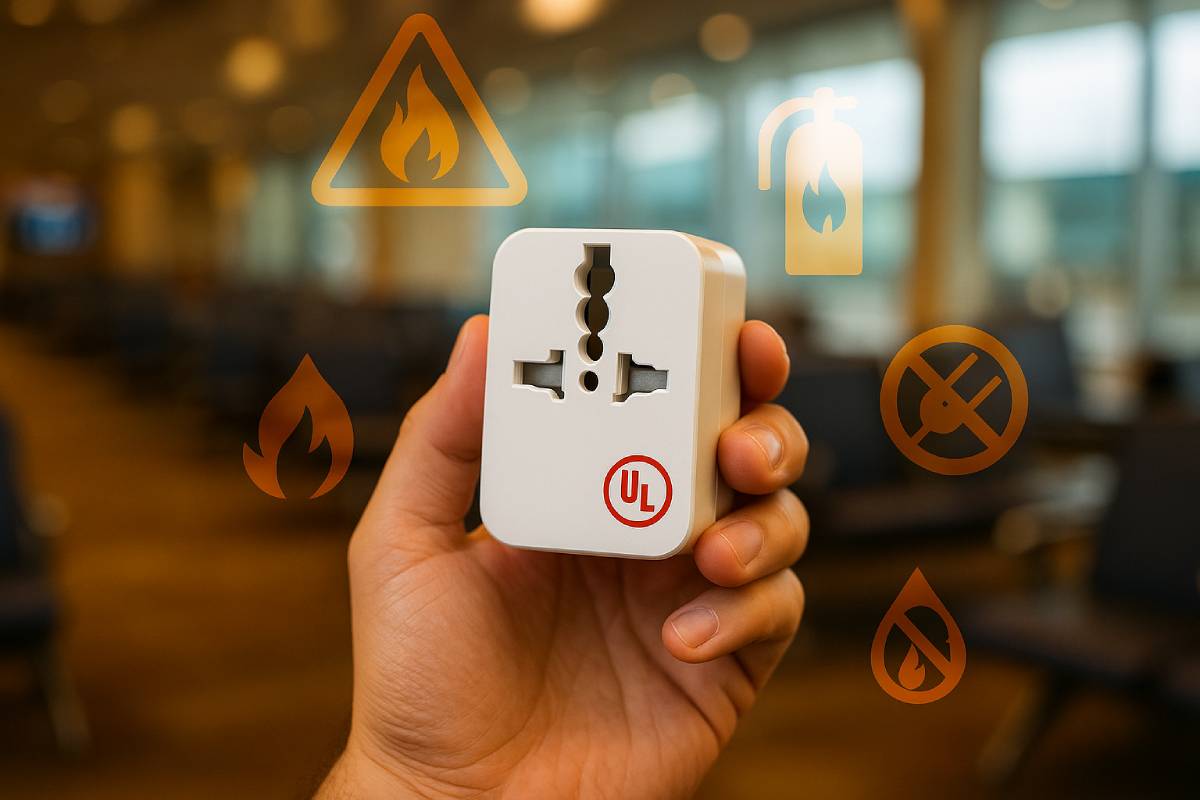

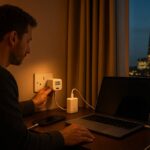

















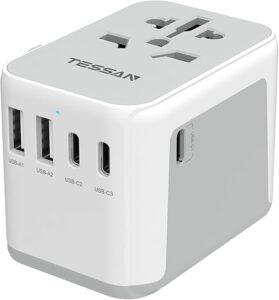
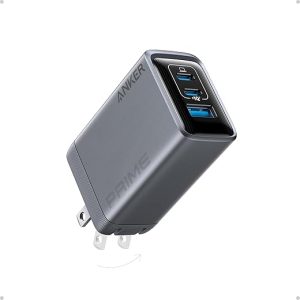
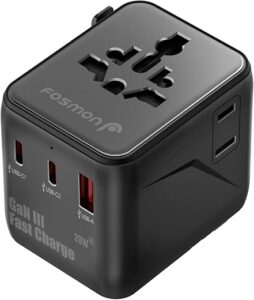
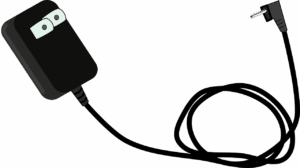
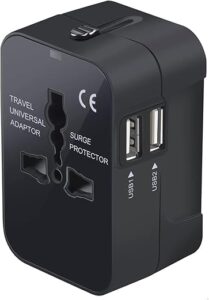
I always keep a spare in my suitcase now—just in case!
They can definitely be a hassle! A checklist might help you remember!
Right? I’ve had to buy a few at airport shops. So overpriced!
Anyone else feel like travel adapters are a necessary evil? 😂 I always forget to pack them!
Absolutely, Olivia! It’s the little things that can save you!
Thanks for sharing! I’ll make sure to check mine before my next trip!
I’m glad you found it useful! Safety first!
This is such great advice! I never thought about checking for damage! Thanks for the tips! ✨
Make sure to check the adapter compatibility for your destination!
Safe travels! Let us know how it goes!
Exciting! Hope you have a fantastic trip, Nathan!
Great tips! I’m traveling to Asia next month and will definitely keep this in mind!
I get that! I learned the hard way too with a cheap one.
Sometimes spending a little more is worth it for safety!
Quality adapters are definitely worth it. Trust me!
I thought I was being smart by getting a cheap adapter. Now, I’m worried I might have to invest in a quality one. 😩
I thought it was just me! Some of this stuff is a bit overwhelming.
Haha, right? Just a little knowledge goes a long way!
It’s true though! Better safe than sorry.
Honestly, who knew travel adapters could be such a fire hazard? I feel like I need a degree just to use mine! 😂
Haha, lucky you! Voltage mismatches can cause serious issues. Glad you’re safe!
I had a friend fry their phone because of that! Total bummer.
Safety should be our priority, no matter where we are.
Yeah, it’s wild how something so small can cause such big problems.
That’s why I always bring a power strip instead of a bunch of adapters!
I had one that didn’t fit in some outlets though, so double-check before your trip!
Exactly! A little caution goes a long way!
You’re welcome, Sophia! Safe travels are always in style!
Universal adapters are a great choice! Just ensure it’s compatible with your devices.
I liked the emphasis on safety! It’s easy to overlook these things when traveling. Thanks for the reminder!
Great info about voltage compatibility! I always thought all adapters were the same. I guess I dodged a bullet last summer in Europe! 😂
Same! I used to overload mine until I found out how dangerous it can be.
It’s easy to do! Just remember, less is more when it comes to safety!
Good luck! I love mine. It’s saved me so much trouble.
Tbh, I wasn’t aware of the different plug types before reading this. Just ordered a universal adapter! Hope it works out!
I think the section on avoiding overloads is crucial! I have this habit of plugging in too many devices at once, especially in hotels. 😬 Gotta be better about that!
I bet a lot of travelers don’t even think about it until it’s too late.
It’s wild, right? I had a friend’s device blow up! No kidding.
Glad you found it useful, Brian! It’s a big topic that needs attention.
Just learned about those voltage compatibility risks. Crazy how many people ignore it! I’ll definitely be more careful. Thanks!
So glad you found it helpful, Sarah! Always better to be safe than sorry! 🌍✈️
Right? I always just assumed they were fine as long as they were in my bag. Lesson learned!
Happy to help, Jessica! Safe travels to you! ✈️🌏
Make sure to check your voltage too! Don’t want any surprises!
I was clueless too! This guide made things so much clearer!
Ugh, I did the same thing once! Now I check everything twice!
This guide is super helpful! I never realized how important it is to check for damage before using my travel adapter. Just the other day, I almost plugged in a cracked one! 😱 Thanks for the tips!
This article is a lifesaver! I’m planning a big trip next month and honestly, I was clueless about adapters. Thank you!
I’m with you! I’ve learned the hard way a few times!
At least we can learn from our mistakes!
I used to think I could charge everything at once. Not anymore!
Glad it helped you, Leo! We all have room for improvement!
Glad it resonated with you, Katherine! Small changes can make a big difference!
Definitely! A little knowledge can prevent a lot of issues!
Haha, we’ve all been there! Better now than later!
Same here! Wish I’d read something like this before.
Just read the part about safe usage practices. I think I’ve been doing it all wrong! Oops! 😂 Thanks for the wake-up call!
Same! Just one device at a time from now on!
I’m guilty of overloading my adapters all the time. 😬 This is a great reminder to be more careful! Thanks for the heads-up!
I always thought these adapters were just plug and play. Good to know there’s more to it!